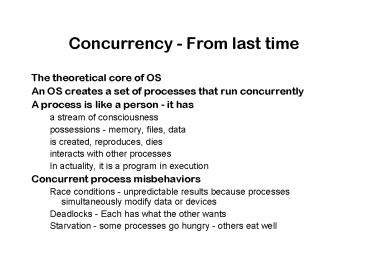Concurrency From last time - PowerPoint PPT Presentation
1 / 10
Title:
Concurrency From last time
Description:
Race conditions - unpredictable results because processes simultaneously ... The up operation increments the counter and awakens a sleeper if the counter was 0. ... – PowerPoint PPT presentation
Number of Views:40
Avg rating:3.0/5.0
Title: Concurrency From last time
1
Concurrency - From last time
- The theoretical core of OS
- An OS creates a set of processes that run
concurrently - A process is like a person - it has
- a stream of consciousness
- possessions - memory, files, data
- is created, reproduces, dies
- interacts with other processes
- In actuality, it is a program in execution
- Concurrent process misbehaviors
- Race conditions - unpredictable results because
processes simultaneously modify data or devices - Deadlocks - Each has what the other wants
- Starvation - some processes go hungry - others
eat well
2
Some operating system ideas - also review
- Everything is a file - even devices
- This allows a program to work with human input,
or a device, or a temporary or permanent file - Interrupt-driven behavior
- Example - windows - process is simultaneously
sensitive to events from mouse, keyboard, process
subsystem, and window manager - Caching - Foreground and background copies
- Used in
- Cache memory
- Swapping
- The disk block cache - recent transactions are in
memory - Networking utilities
3
Processes and their states
- The process state includes the following
- Running/ready/blocked (waiting on an
event/events) - Priority
- Kernel/User mode
- In-memory/swapped
- Process ID
- Priority
- The process owns
- U-area (but user cant examine/modify it)
- Entries in the system open-file table
- Its own file control blocks (linked to the system
table) - Its own memory space
4
The system process table
- Used for scheduling and control of processes
- Scheduler acts on timer interrupt or a process
state change - It schedules the highest-priority process that is
ready - It causes a context switch (gives the process
control) - This mechanism
- Gives system and I/O processes high priority
- Keeps the CPU puercos from monopolizing
- Interrupts are outside process country
- This avoids make a context switch for each
interrupt - It means the interrupt service routines use only
the kernels memory
5
Mutual Exclusion - software solutions
- Unsuccessful solutions (on separate slides)
- Strict alternation
- Algorithms where mutual exclusion fails
- Petersons algorithm
- Description of Bakery Algorithm
- Just like Baskin-Robbins - incoming process takes
a number - Since two users can grab same number,
lowest-number process gets priority
6
Avoiding busy waiting - Semaphores and messages
- Classical semaphores
- The semaphore is an ADT with a counter, a process
queue, and two operations - The down operation sleeps enqueued if the counter
is zero, and then decrements the counter - The up operation increments the counter and
awakens a sleeper if the counter was 0. - The down operation enters a critical section, the
up leaves it. - Messages
- Reliable messages to an administrator work like a
down or up - Messages and semaphores are equivalent
- Thats why
7
Semaphores and messages - continued
- Mistakes are easy
- Deadlock
- Geteway-controlling and resource-controlling
semaphores
8
Language Mechanisms - Monitors
9
Classical IPC problems
- Producer-consumer
- Scenario
- Producer produces information
- Consumer consumes it
- Both must wait on buffer availability
- Problem resembler disk I/O and print servers
- Code
- Readers-Writers
- Scenario
- Readers can write whenever no writer is active
- Writers must have solitude
- Problem resembles database
- Code
- Dining Philosphers
- Scenario
- N philosophers think, wait for chopsticks, and
eat - Problem is useless but illustrative
- Code
10
(No Transcript)































